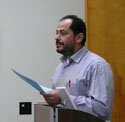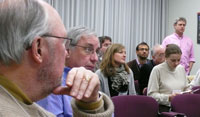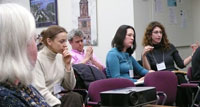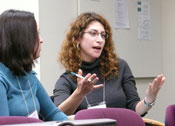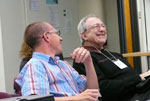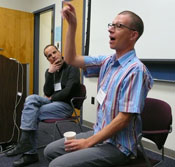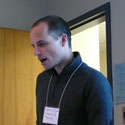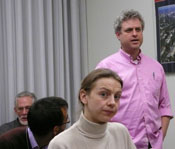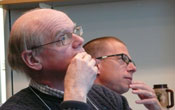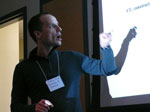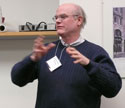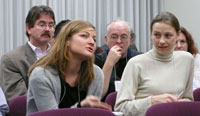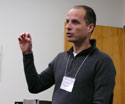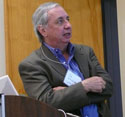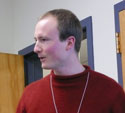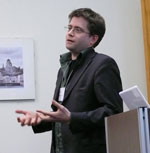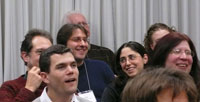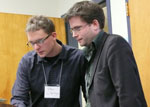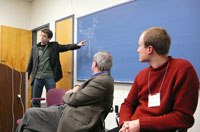

![]()
::: postdoc fellowships
::: senior fellowships
::: resident fellowships
::: associateships
![]()
being here
::: visiting
::: the last donut
::: photo album
::: center home >> being here >> last donut? >> 26 january 2008 |
Saturday, 26 January 2008
The hope when you plan a workshop is that you can bring together people with different viewpoints, put them in one room and get them to talk until some beneficial closure arises. In some ways, it is akin to the strategy used when cardinals are locked down at the Vatican until they elect a new Pope. While we never quite got to elect a new Pope, there was a clear sense of real engagement between differing views in both morning and afternoon sessions. In both, we had purchased a full hour of discussion time by restricting speakers to thirty minutes each speaking time only. It was a good bargain. We had no trouble at all filling the discussion time. The papers of the morning session were powerful and interesting. The topic was causation in physics, or, more bluntly, whether there really is any. Weighing in on the somewhat skeptical side, Sheldon Smith argued against a commonly overlooked element of the folklore of causation. That folklore says that there are at least some simple cases in which causal relations can be decomposed into pieces, each of which can be analysed independently. Then we can compose the component causes with their associated effects and recover the full behaviour of the original system. His counterexample was a simple system of an oscillating spring. It is one for which the composition ought to work, if it works anywhere at all. Yet, as he showed, when we combine springs in ways naturally suggested by the composition of causes, the resultant motion is not the sum of the component motions. All that was a mere introduction for his deeper moral. While we may like to apply causal talk to physical systems, that sort of talk is an unreliable way to plumb the properties of physical systems. We are as likely to be misled by spurious notions such as the composition of causes. The better course is to look for illumination in the fundamental physical laws and in the differential equations that express them.
The afternoon session fully carried the energy of the morning. We now had three speakers and the topic was interventionism. Just what happens when this causes that? We are inclined to say that it is obvious: this brings about that; this is the "oomph" that leads to that; and so on... until we realize that we are merely parading synonyms. Interventionism seeks to be a little more informative. How this and that are related when one causes the other is understood in terms of interventions. We find, for example, that if we manipulate people's cholesterol levels--that is, if we intervene on them, we then find corresponding changes in their rates of heart disease. When that happens, we routinely say that high cholesterol is a cause of heart disease.
So, Jim proposed, it is the same with causation in the special sciences. When we say that low socio-economic status inclines one to-- that is, causes-- drug usage, we are giving a coarse grained description of processes that could also, impractically, be talked about in some physical theory. When we give that coarse grained description, we become aware of new relations not visible before and they are the causal relations. When we look very closely at the underlying physical processes, we cannot see the causal forest for the physical trees. And this forest, of course, comports with the interventionist view of causation.
Of course that is a crude gloss on a much more refined analysis that has been elaborated for over two decades by our colleagues in the Philosophy Department at neighboring Carnegie Mellon University. Frederick, a recent PhD from that department, gave us a lively tutorial that ended in his most recent findings on just how much and just how little these techniques can deliver. His elegantly animated screens were filled with the terms of art: Bayes' nets, hard interventions, soft interventions, latent variables and more. Those hearing this material for the first time, I discovered in the break, found this approach a revelation.
So causes are defined in terms of interventions; and interventions are defined in terms of causes. How are we to understand this? If the possibility of an intervention is part of what it is to be a cause, then we must have the possibility of an intervention on the intervention; and an intervention on the intervention on the intervention; and so on indefinitely. Here was an infinite regress, whose implications Michael teased out in the time given to his talk. The gauntlet had been thrown down by Michael in a room packed with interventionists. It was picked up by many in the discussion that followed. The first was Clark Glymour, who, with characteristic theater, began his question by asking Michael to raise the projection screen. We waited in anticipation as it rose and there was a bunch of letters connected by arrows. There was a sense that some sort of point had been made by this little piece of drama. Even later there seemed to be no agreement on quite what the point was. In any case, these letters and arrows had deep meaning for the experts who proceeded to debate energetically in pronouncements heavily peppered with talk of theorems and properties and "colliders." I was trying to keep score and track where the discussion ended. My sense was that there was some type of converge onto the idea that interventionist ideas do not and were never intended to define the causal relation, but merely to offer a sufficient condition that reveals when a causal relation obtains; that condition itself requires some sort of independent access to causal notions. Depending on where you were sitting, that seemed either to be a revelation (my corner) or old news (the back of the room). My feeling, even after a long discussion, was that we have not heard the end of this. John D. Norton |
